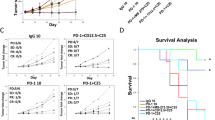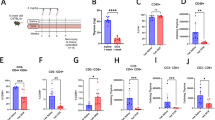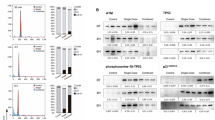Abstract
Immunodeprived mice survived a high, otherwise lethal dose of cyclophosphamide (Cy) provided they had been "primed" with a low dose (50 mg kg-1) of the drug 4 days earlier. These combinations were then tested on 2 oat cell xenograft lines (which are known to reproduce the chemotherapeutic responses of the parent tumours) grown in immunodeprived mice. In the treatment of the first oat cell xenograft, 200 mg kg-1 Cy produced a growth delay of 34 days in the unprimed group and 45 days in the primed group. At a dose of 300 mg kg-1 a growth delay could not be assessed in the control group as 16/17 of these unprimed mice bearing this xenograft died. However, 14/22 tumours went into complete remission in this group before death occurred. In contrast only 3/16 deaths occurred in the group of mice that were primed before receiving the same challenge dose. In these animals 19/26 tumours went into complete remission and were still completely absent when the experiment was terminated at 60 days. Using the second oat cell xenograft, 300 mg kg-1 Cy produced a growth delay of 27 days. However, at this dose level all the animals were dead by day 46. In mice which had been primed with 50 mg kg-1 Cy 4 days before the administration of 300 mg kg-1 a growth delay of 32 days was achieved and 2/9 animals were alive at day 60. This study shows that priming allows larger doses of Cy to be given to immunodeprived mice bearing human tumour xenografts than would normally be tolerated and that the priming does not alter the anti-tumour efficacy of the large challenge dose as measured by tumour growth delay or complete remission rate. As the tumours were human in origin it raises the question whether high dose cyclophosphamide therapy and priming have a role to play in the treatment of patients with oat cell carcinoma.
This is a preview of subscription content, access via your institution
Access options
Subscribe to this journal
Receive 24 print issues and online access
$259.00 per year
only $10.79 per issue
Buy this article
- Purchase on SpringerLink
- Instant access to full article PDF
Prices may be subject to local taxes which are calculated during checkout
Similar content being viewed by others
Rights and permissions
About this article
Cite this article
Evans, B., Smith, I. & Millar, J. High dose cyclophosphamide treatment of human oat cell xenografts in immune deprived mice. Br J Cancer 47, 215–219 (1983). https://doi.org/10.1038/bjc.1983.29
Issue date:
DOI: https://doi.org/10.1038/bjc.1983.29



